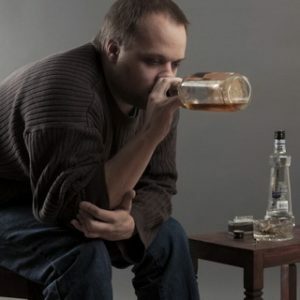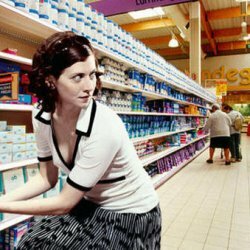Drinking: signs, consequences, methods of deducing from a booze

Drinking is one of the forms of alcohol abuse in chronic alcoholism.It manifests itself in a sudden increase in the intake of alcohol.Drunken state is accompanied by a certain cyclicity.
In addition to drinking binges, alcoholic dependence is accompanied by a constant( daily) form of drunkenness and intermittent( the development of drunken excesses against the background of a constant form of abuse).Drunken form refers to the most malignant variants of the current.Clearly, this problem appears at the stage of development of the second stage of alcoholism.Most patients suffer this kind of abuse.
Please note: if drinking alcoholic drinks, a person drinks an excessive dose of alcoholic beverages per day.With no help after the end of the binge, the patients often develop psychosis.
Contents: What causes the binge What are bingesWhat causes the binge
Long-term abuse of alcohol leads to a metabolic disorder.In particular, the correlation, development, isolation and catabolism of neurotransmitters, which control the regulatory role of many functions of the body, is violated.
Formed alcohol dependence requires the constant receipt of all new doses of alcohol.Long-term abstinence leads to accumulation of some mediators, and a decrease in others.So, periodically advancing release of catecholamines( adrenaline, norepinephrine, dopamine) into the blood causes the appearance of the physical component of craving for alcohol.
The body requires neutralization of these compounds with alcohol.Against this background, the alcoholic begins to consume large doses of alcohol after abstinence.There is a disruption in the adaptive capacity, to which the neuro-psychic component and psychic dependence are layered. The patient begins to drink until the exhaustion of their capabilities.This is the essence of the binge. Let's try to understand the types and manifestations of this dangerous state of health.
What are the binges of
Drinking begins with a dramatic, insurmountable attraction to taking large doses of alcohol.Being in this state, a person can not stop at small or medium amounts drunk. Craving for alcohol unrestrained, in some ways it can be called violent.The patient during the excesses ceases to worry absolutely everything: work, family, problems, health, duties.There is only one goal - the attainment of a state of strong intoxication. There are hardly any sober intervals from the beginning of the binge to the end.
Short-term brews
 A drench that lasts 2-3 days, sometimes slightly longer - 5-7 days, is typical for the end of I and the beginning of II stage.This form can be combined with one-day episodes of intoxication .Unlike the heavier types of binge, the short-term form may be interrupted for reasons of acute need at work or other points, such as lack of funds.
A drench that lasts 2-3 days, sometimes slightly longer - 5-7 days, is typical for the end of I and the beginning of II stage.This form can be combined with one-day episodes of intoxication .Unlike the heavier types of binge, the short-term form may be interrupted for reasons of acute need at work or other points, such as lack of funds.
The withdrawal syndrome is poorly expressed. Some narcologists attribute this option to "false" binges. The amount of alcohol consumed in the drinking phase can vary.On average, it is 0.5-0.7 liters of spirits.Beginning of a short-term binge, the patient tries, for the sake of justification, to confine himself to some event, so as not to "advertise" the resulting craving.Most often it is about "relaxation" at the end of the working week - at the end of Friday, Saturday and Sunday.In the morning on Monday, the sobered one takes up his duties.
With short-term forms of drinking bouts, desocialization is not yet developing.The hangover is taking place against the background of taking brine, mineral water, "pop".
Please note: short-term drunkenness can be interrupted by the creation of external circumstances - a scandal, the need for some participation of a drinker in an urgent matter, etc.Such a state of things can last for years.
But the disease is gradually progressing, the phenomena of degradation are growing.Gradually short-term binges are replaced by long, "true" ones.
Long drinking bouts
The main feature of true binges is the cyclicity of .Each patient has its own duration of excesses and light intervals between them. As the alcoholism progresses, binges are shortened, and sober "bands" on the contrary - increase. True drinking lasts more than a few days.The interval between the two drunken phases is much longer in time than the binge itself.A bright gap can be from a few weeks to several months. For example - "quarterly" drunkenness, in which the interval between bouts is 3 months.
The beginning of the binge is preceded by neuropsychic changes - psychomotor anxiety, apathy, depression, irritability, anxiety, etc.Suddenly develops a strong desire for alcohol.About this patient relatives say - "as a chain broke."A person who suffers alcoholism drinks very much.In the morning, as a rule, the dose is small.In the afternoon, late in the evening, the patient drank the main dose, while intoxication reached its apogee.Especially - in the early days of drunkenness. Some alcoholics can drink 3 or more liters of strong alcohol for knocking.Protective gag reflex is absent.During the drinking-bout, the patients practically do not eat or drink anything.They cease to care for their own appearance, cleanliness.Bustard most often sits or lies at home, nowhere goes the .
Quantitative and situational control is lost completely.In the second half of the binge, the dose begins to decrease.With abstinence, a severe abstinence syndrome develops, which the patient hastens to remove with a subsequent dose of alcohol.In neglected forms of diseases, this occurs, including, at night.Patients suffer from insomnia, periodically "falling through" into nightmarish dreams that prevent them from resting and recovering their strength.Periodical hallucinatory experiences may occur.
By the end of the drinking-bout, there is maladjustment of the body, expressed intoxication is the main factor in reducing thrust.In the "move" are weak alcoholic beverages.Drinking during a drinking bout completely loses its ability to work.Completion of alcohol-drunken kurtosis leads to an exacerbation of chronic pathology.
The binge is stopped by the return of the vomiting reflex( an aversion syndrome).The patient can not tolerate even the sight of alcohol.Sometimes it is not possible to drink even water.
The patient develops and observes :
- slow motion;
- is a shaky walk;
- trembling all over the body and especially the hands,
- angina attacks, heart rhythm disturbances;
- hepatic failure with pain in the right upper quadrant and epigastric( gastric) area;
- open healed ulcers of the intestinal tract;
- develops neurological pathologies.
 Vomiting is accompanied by diarrhea.On 3-4 days after leaving the binge, a possible danger is the possible development of alcoholic psychosis( white fever).
Vomiting is accompanied by diarrhea.On 3-4 days after leaving the binge, a possible danger is the possible development of alcoholic psychosis( white fever).
For several days, a pronounced asthenic condition with complete intolerance to alcohol is maintained.Gradually aversion to alcoholic beverages goes away.
In the intervals between drinking bouts, patients lead a normal lifestyle, do not consider themselves to be drinking and dependent .At this time, many people have a compensatory rise in their strength, an improved mood.However, gradually, mental dependence makes itself felt by memories, stories, expectations.Alcohol degradation is gradually doing its job. After every bitter episode, the personality of a person changes, becomes primitivized, flattened.Over time, people start to notice it.
Note: some patients have resistance to alcohol.During the drinking-bout they manage to maintain their ability to work, despite significant alcoholization.
Pseudo-seps
The variant of periodic alcohol abuse, which causes not pathological internal causes( mechanisms), but external factors, called situational, or pseudo-dust.
This group of patients was well defined during the USSR, when a large number of people worked in large industrial plants and enterprises, which twice a month were given money - an advance and a salary.It was in these days that nearby "pivnuhi" were filled with workers who had time to "drink through" part of the money they had earned in 2-3 days.But administrative influences, domestic scandals, other circumstances quickly interrupted alcoholization.The subsequent sobriety was held until the next payday.
Some semblance of pseudo-sashes can be observed in our time during holidays, big holidays, then gaps, etc. .Pseudosections can last longer than the true forms of this pathology.The condition of patients does not reach such a degree of severity as in the case of true variants.That's why pseudo-sores last longer.Cyclicity is completely absent.Pseudozapa can repeat a week after the end of the previous, and may be absent six months and longer.In some cases, combinations of the signs of both variants are seen, in this case, differential diagnosis is difficult.
Currently, in narcology, the division of binges by types is practically not applied, in view of its irrelevance.Attention is drawn to the severity of this problem and the state of the drinker.
Dipsomania
Dipsomania is a variant of periodic alcohol abuse in a person who is not an alcoholic.
Dipsomania is preceded by an existing anxiety state in the patient, depression, sleep problems, and other mental disorders.Dipsomaniacs during alcohol intake are often accompanied by a desire for non-purposeful trips( dromomania), dissolved sexual behavior.This type of drinking-bout can last as several days, and several weeks.A number of researchers consider it a combination of mental pathology, which the patient has against the background of taking alcohol.
Busting
Bleeding is one of the most common types of drug treatment.Treatment is carried out on an outpatient basis, at home and in the hospital.
Therapeutic complex includes:
-
 Detoxifying agents - magnesium sulfate, B vitamins, sodium thiosulfate, amino acid solutions, plasma substitutes, rheosorbylact.
Detoxifying agents - magnesium sulfate, B vitamins, sodium thiosulfate, amino acid solutions, plasma substitutes, rheosorbylact. - Symptomatic therapy - according to indications prescribe heart stimulants, antispasmodics, coronarolytics, hepatotropic drugs.
- Soothing therapy - bromine medicines, infusion of passionflowers.
- Sleeping pills and medicine Popova( for the prevention of white fever).
- Tranquilizers - phenazepam, meprotan.
- Mild antipsychotics( with hallucinatory vigilance and psychopathic abnormalities).
- Drugs with an anabolic effect - piracetam, pyriditol.
- Non-pharmacological methods of cleaning the body - laser irradiation of blood, intestinal lavage, plasmapheresis.
An effective method of helping with drinking-bout is hyperthermia, which can quickly remove withdrawal symptoms and craving for alcohol.
For the removal of traction, emetic-sensitizing therapy is used.The desired effect is achieved by a combination of medications that induce vomiting and drugs that are incompatible with alcohol.This leads to the formation of a conditioned reflex rejection of alcoholic beverages.
After removal from the binge, it is recommended to continue treatment, undergo a final treatment - coding, rehabilitation course with psychotherapy.
Forecast
The prospects of a drinking person depend on the stage of the alcoholic process, the mental and physical health of the patient .People with alcoholic drinking are much more at risk of getting heart attacks, strokes, and neurological complications.The result of treatment depends on the awareness of your illness and desire to get rid of alcohol abuse.
Alexander Lotin, medical reviewer



